Eager To Know What The Control Panel Warning Lights In Your Cars And Truck Represent? Explore Their Definitions For The Well-Being And Safety Of Your Vehicle
Eager To Know What The Control Panel Warning Lights In Your Cars And Truck Represent? Explore Their Definitions For The Well-Being And Safety Of Your Vehicle
Blog Article
Web Content Author-Vinson Forbes
When you lag the wheel, those radiant warning lights on your control panel can be a bit bewildering. Do you recognize what they're trying to tell you concerning your car's wellness? Comprehending the relevance of these lights is vital for your safety and the longevity of your vehicle. So, the next time one of those lights appears, wouldn't you intend to decode its message accurately and take the required steps to resolve it?
Common Caution Lights and Interpretations
Identify typical warning lights in your cars and truck and recognize their meanings to guarantee safe driving.
One of the most typical warning lights consist of the check engine light, which indicates concerns with the engine or emissions system. If this light begins, it's crucial to have your car inspected quickly.
The oil pressure cautioning light indicates low oil stress, requiring prompt focus to avoid engine damage.
A blinking battery light may suggest a malfunctioning billing system, possibly leaving you stranded otherwise dealt with.
The tire stress surveillance system (TPMS) light informs you to low tire stress, influencing automobile stability and gas effectiveness. Ignoring this could lead to hazardous driving conditions.
The abdominal muscle light suggests a trouble with the anti-lock stopping system, jeopardizing your capability to stop rapidly in emergencies.
Last but not least, the coolant temperature level cautioning light warns of engine getting too hot, which can result in serious damage if not fixed swiftly.
Understanding these usual caution lights will aid you attend to concerns immediately and maintain safe driving conditions.
Significance of Prompt Focus
Understanding the common caution lights in your car is only the first step; the value of without delay resolving these cautions can not be emphasized enough to guarantee your safety and security when traveling.
When a warning light illuminates on your dashboard, it's your cars and truck's means of interacting a potential problem that requires interest. Ignoring these cautions can cause much more extreme issues down the road, compromising your safety and potentially costing you a lot more out of commission.
https://www.repairerdrivennews.com/2022/03/07/minnesota-bills-aim-to-use-auto-service-parts-sales-tax-revenue-to-fund-roads-bridges/ to cautioning lights can protect against malfunctions and accidents. For example, a flashing check engine light can show a misfire that, if left ignored, might create damages to the catalytic converter. Addressing this immediately can conserve you from an expensive repair work.
In a similar way, a brake system cautioning light might signal reduced brake fluid or worn brake pads, critical parts for your safety when driving.
Do It Yourself Troubleshooting Tips
If you notice a caution light on your dashboard, there are a few do it yourself repairing ideas you can attempt prior to seeking professional assistance.
The primary step is to consult your cars and truck's manual to understand what the particular warning light shows. In some cases the issue can be as basic as a loosened gas cap setting off the check engine light. Tightening up the gas cap may fix the problem.
detailing rv is a low battery, which can cause different advising lights. Examining the battery links for corrosion and guaranteeing they're safe may deal with the problem.
If a warning light continues, you can try resetting it by separating the auto's battery for a few minutes and after that reconnecting it. Furthermore, inspecting your car's fluid levels, such as oil, coolant, and brake fluid, can aid repair cautioning lights connected to these systems.
Final thought
To conclude, understanding your car's caution lights is essential for keeping your car running efficiently and securely. By immediately attending to these signals and knowing what they imply, you can avoid costly fixings and possible malfunctions.
Keep in mind to consult your automobile's guidebook for specific information on each alerting light and take action accordingly to ensure a trouble-free driving experience.
Stay educated, stay secure when driving!
